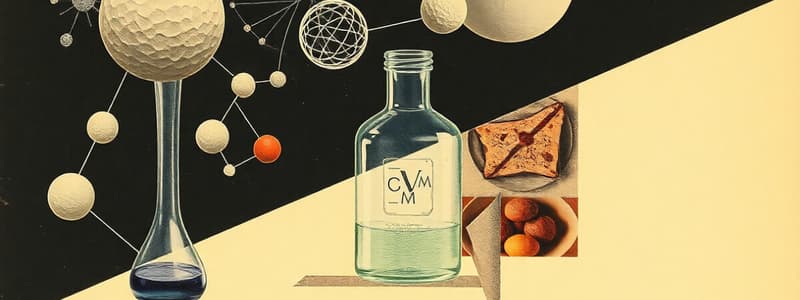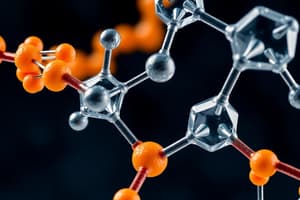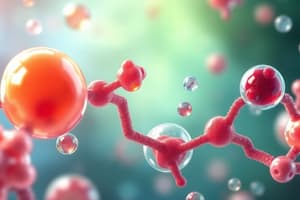Podcast
Questions and Answers
What is the primary role of carbohydrates in the human body?
What is the primary role of carbohydrates in the human body?
- Provide a primary source of energy (correct)
- Store information in DNA
- Act as enzymes in chemical reactions
- Regulate body temperature
Which of the following statements is true about lipids?
Which of the following statements is true about lipids?
- They function solely in energy storage.
- They consist mostly of hydrophobic chemical moieties. (correct)
- They include carbohydrates as a subclass.
- They are primarily hydrophilic molecules.
What defines biochemistry as a field of study?
What defines biochemistry as a field of study?
- The investigation of cosmetic products' marketing strategies
- The understanding of cellular architecture
- The analysis of energy production in cells
- The study of chemical substances and vital processes in live organisms (correct)
How is glycogen primarily stored in the human body?
How is glycogen primarily stored in the human body?
What is the significance of understanding biochemistry in relation to cosmetic products?
What is the significance of understanding biochemistry in relation to cosmetic products?
Which cellular organelles are primarily influenced by biochemistry?
Which cellular organelles are primarily influenced by biochemistry?
What are the essential processes performed by a human cell classified as?
What are the essential processes performed by a human cell classified as?
Which type of sugar is NOT part of carbohydrate classifications?
Which type of sugar is NOT part of carbohydrate classifications?
What is the term used for the process where a cell decreases the quantity of a cellular component in response to an external stimulus?
What is the term used for the process where a cell decreases the quantity of a cellular component in response to an external stimulus?
Which statement accurately describes the difference between the genome and epigenome?
Which statement accurately describes the difference between the genome and epigenome?
Which of the following describes the function of enzymes in biochemical reactions?
Which of the following describes the function of enzymes in biochemical reactions?
Which of the following products is known to have epigenetic effects?
Which of the following products is known to have epigenetic effects?
What role do cofactors play in enzyme activity?
What role do cofactors play in enzyme activity?
What is upregulation in the context of gene expression?
What is upregulation in the context of gene expression?
What characteristic of enzymes allows them to sustain life at normal body temperatures?
What characteristic of enzymes allows them to sustain life at normal body temperatures?
Which factor does NOT influence epigenetic modifications?
Which factor does NOT influence epigenetic modifications?
What type of amino acids must be obtained through the diet?
What type of amino acids must be obtained through the diet?
Which nitrogenous base is only found in RNA?
Which nitrogenous base is only found in RNA?
What is the primary function of DNA in a cell?
What is the primary function of DNA in a cell?
Which of the following is NOT a function of proteins?
Which of the following is NOT a function of proteins?
Which components make up a nucleotide?
Which components make up a nucleotide?
Which of the following describes the structure of RNA?
Which of the following describes the structure of RNA?
How are the two polynucleotide strands in DNA connected?
How are the two polynucleotide strands in DNA connected?
What is a codon?
What is a codon?
Which biomolecule cannot be synthesized by human cells and must be obtained from the diet?
Which biomolecule cannot be synthesized by human cells and must be obtained from the diet?
What is the sugar component in DNA?
What is the sugar component in DNA?
What is the role of messenger RNA in the process of transcription?
What is the role of messenger RNA in the process of transcription?
Which of the following correctly describes the flow of genetic information in the central dogma of molecular biology?
Which of the following correctly describes the flow of genetic information in the central dogma of molecular biology?
During translation, what is the function of transfer RNA (tRNA)?
During translation, what is the function of transfer RNA (tRNA)?
What occurs at the initiation codon AUG during translation?
What occurs at the initiation codon AUG during translation?
How does the polypeptide chain elongate during translation?
How does the polypeptide chain elongate during translation?
What is a polysome?
What is a polysome?
What happens when a stop codon is reached during translation?
What happens when a stop codon is reached during translation?
What is the relationship between transcription and translation in protein synthesis?
What is the relationship between transcription and translation in protein synthesis?
What type of enzyme specificity allows an enzyme to act on a specific type of chemical bond?
What type of enzyme specificity allows an enzyme to act on a specific type of chemical bond?
How do the majority of enzymes derive their names?
How do the majority of enzymes derive their names?
What happens to enzymes when the temperature exceeds optimal levels?
What happens to enzymes when the temperature exceeds optimal levels?
Which step does NOT occur during enzyme activity?
Which step does NOT occur during enzyme activity?
What is the concept that describes the interaction between an enzyme and its substrate, much like a key fits a lock?
What is the concept that describes the interaction between an enzyme and its substrate, much like a key fits a lock?
Which factor does NOT significantly affect enzyme activity?
Which factor does NOT significantly affect enzyme activity?
What type of enzyme would likely break down fats?
What type of enzyme would likely break down fats?
Which statement best describes group specificity in enzymes?
Which statement best describes group specificity in enzymes?
What distinguishes reversible enzyme inhibitors from irreversible ones?
What distinguishes reversible enzyme inhibitors from irreversible ones?
Which statement correctly describes ATP?
Which statement correctly describes ATP?
What is the primary role of Co-enzyme Q10 in the body?
What is the primary role of Co-enzyme Q10 in the body?
What is the main function of the rough endoplasmic reticulum (ER)?
What is the main function of the rough endoplasmic reticulum (ER)?
Which organelle is primarily responsible for the digestion of obsolete cell components?
Which organelle is primarily responsible for the digestion of obsolete cell components?
Which statement about peroxisomes is accurate?
Which statement about peroxisomes is accurate?
What is the primary role of mitochondria in cells?
What is the primary role of mitochondria in cells?
What function does the Golgi apparatus serve in the cell?
What function does the Golgi apparatus serve in the cell?
Flashcards
What is biochemistry?
What is biochemistry?
The study of the chemical substances and vital processes that occur in living organisms.
What is a human cell?
What is a human cell?
A complex structure within cells that carries out essential processes for survival, growth, and reproduction.
What are carbohydrates?
What are carbohydrates?
A type of biomolecule that provides the primary source of energy for the body. They are water-soluble and stored as glycogen in the liver and muscles.
What are lipids?
What are lipids?
Signup and view all the flashcards
What is ATP?
What is ATP?
Signup and view all the flashcards
What are enzymes?
What are enzymes?
Signup and view all the flashcards
What are cofactors?
What are cofactors?
Signup and view all the flashcards
What is DNA replication?
What is DNA replication?
Signup and view all the flashcards
Transcription
Transcription
Signup and view all the flashcards
Translation
Translation
Signup and view all the flashcards
Codon
Codon
Signup and view all the flashcards
Messenger RNA (mRNA)
Messenger RNA (mRNA)
Signup and view all the flashcards
Transfer RNA (tRNA)
Transfer RNA (tRNA)
Signup and view all the flashcards
Ribosome
Ribosome
Signup and view all the flashcards
Initiation Codon (AUG)
Initiation Codon (AUG)
Signup and view all the flashcards
Stop Codon
Stop Codon
Signup and view all the flashcards
Lipids
Lipids
Signup and view all the flashcards
Fatty acids
Fatty acids
Signup and view all the flashcards
Triglycerides
Triglycerides
Signup and view all the flashcards
Phospholipids
Phospholipids
Signup and view all the flashcards
Steroids
Steroids
Signup and view all the flashcards
Amino acids
Amino acids
Signup and view all the flashcards
Peptides
Peptides
Signup and view all the flashcards
Proteins
Proteins
Signup and view all the flashcards
ATP
ATP
Signup and view all the flashcards
DNA
DNA
Signup and view all the flashcards
Genome
Genome
Signup and view all the flashcards
Epigenome
Epigenome
Signup and view all the flashcards
Gene Regulation
Gene Regulation
Signup and view all the flashcards
Downregulation
Downregulation
Signup and view all the flashcards
Upregulation
Upregulation
Signup and view all the flashcards
Enzymes
Enzymes
Signup and view all the flashcards
Cofactors
Cofactors
Signup and view all the flashcards
Enzyme Catalysis
Enzyme Catalysis
Signup and view all the flashcards
What is the active site of an enzyme?
What is the active site of an enzyme?
Signup and view all the flashcards
Explain the 'lock and key' theory of enzyme function.
Explain the 'lock and key' theory of enzyme function.
Signup and view all the flashcards
What is an enzyme-substrate complex?
What is an enzyme-substrate complex?
Signup and view all the flashcards
What factors affect enzyme activity?
What factors affect enzyme activity?
Signup and view all the flashcards
What is enzyme denaturation?
What is enzyme denaturation?
Signup and view all the flashcards
What are hydrolases?
What are hydrolases?
Signup and view all the flashcards
What are oxidases?
What are oxidases?
Signup and view all the flashcards
What are enzyme inhibitors?
What are enzyme inhibitors?
Signup and view all the flashcards
What are the types of enzyme inhibition?
What are the types of enzyme inhibition?
Signup and view all the flashcards
What is ATP and its function?
What is ATP and its function?
Signup and view all the flashcards
What is Co-enzyme Q10?
What is Co-enzyme Q10?
Signup and view all the flashcards
What is the electron transport chain?
What is the electron transport chain?
Signup and view all the flashcards
What are centrioles?
What are centrioles?
Signup and view all the flashcards
What are peroxisomes?
What are peroxisomes?
Signup and view all the flashcards
What does the Golgi apparatus do?
What does the Golgi apparatus do?
Signup and view all the flashcards
Study Notes
Principles of Biochemistry
- Biochemistry is the study of chemical substances and vital processes in living organisms.
- Topics covered include DNA replication and transcription, enzymes and cofactors, ATP, and energy production.
Introduction to Biochemistry
- Cosmetic products often claim to influence biochemical skin processes.
- Some products claim to supply compounds that decline with aging, others to enhance or decrease cellular organelle activities.
- A thorough understanding of biochemistry is crucial to appreciate the proposed mechanisms of action.
Definition of Biochemistry
- Biochemistry is the study of the chemical substances and vital processes occurring in living organisms.
Structure of an Animal Cell
- Includes a diagram showing organelles like the mitochondria, ribosomes, Golgi complex, plasma membrane, nucleus (with nucleolus and nuclear pores), endoplasmic reticulum (rough and smooth), peroxisome, and secretory vesicles.
- A link is provided for more detailed explanations for each cellular part.
- Human cells are complex bioreactors and perform all required processes for survival, growth and reproduction.
Biomolecules - Carbohydrates
- Carbohydrates are divided into monosaccharides, disaccharides, oligosaccharides, and polysaccharides.
- They serve as a primary energy source for the body and are stored as glycogen in the liver and muscles.
- Carbohydrates are water-soluble.
Biomolecules - Lipids
- Lipids are organic molecules primarily composed of mostly hydrophobic chemical moieties, such as fatty acids, sterols.
- Major types of lipids include triglycerides, phospholipids, and ceramides.
- Sterols like cholesterol, testosterone, and estrogen are also lipids.
Biomolecules - Amino Acids, Peptides, and Proteins
- There are 21 different types of amino acids, 9 essential (need to be obtained from diet).
- Amino acids have an amine group, carboxylic acid group, and a variable R-group.
- They form proteins via peptide bonds.
- Proteins have a variety of structures (primary, secondary, tertiary, quaternary).
Biomolecules - Other Small Molecules
- ATP, hormones (e.g., cAMP, NO, hydrocortisone), vitamins (co-factors essential in biological processes and can't be synthesized by the human cells), and minerals are covered.
Biomolecules - Nucleic Acids
- DNA (deoxyribonucleic acid) and RNA (ribonucleic acid) are nucleic acids.
- The structural unit is the nucleotide.
- Nucleotides consist of a phosphate group, a pentose sugar (5-carbon), and a nitrogenous base.
The Nitrogenous Bases
- There are 5 different nitrogen containing bases: Adenine (A), Thymine (T), Cytosine (C), Guanine (G), and Uracil (U).
- A and G are large two-ringed bases (purines).
- C, T, and U are smaller, single-ringed bases (pyrimidines).
DNA Structure
- DNA is double-stranded forming a double helix.
- The two strands are joined by hydrogen bonds between complementary base pairs (A with T, C with G).
- Alternating sugar and phosphate molecules form the backbone of each DNA strand.
- Sugar in DNA is deoxyribose.
- Nucleotides are joined via phosphodiester linkages.
RNA Structure
- RNA is single-stranded.
- The sugar in RNA is ribose.
- Bases in RNA are A, U, C, and G.
- There are three main types of RNA: tRNA, rRNA, and mRNA.
Summary: DNA vs RNA
- DNA is the genetic material, directing protein synthesis & self-replicating; located in the nucleus.
- RNA carries out genetic instructions; found in the cytoplasm; involved in protein synthesis.
- Summary table of differences (Major cellular site, Major function, Sugar, Bases, Structure) is presented.
DNA → RNA → Amino Acids
- DNA is the master blueprint for protein synthesis.
- A gene is a segment of DNA that codes for a polypeptide chain.
- Information is in the sequence of bases.
- Codons consist of three bases and encode amino acids.
- Processes involved are transcription and translation.
The Central Dogma of Molecular Biology
- DNA is transcribed into RNA.
- RNA is translated into protein.
Transcription - RNA Synthesis
- DNA stays in the nucleus.
- RNA copies DNA's information and carries the "code" to the cytoplasm for protein synthesis.
- The process of copying is transcription.
Translation - Protein Synthesis
- Translation occurs in ribosomes (free or bound).
- Transfer RNA (tRNA) links mRNA to proteins/amino acids.
- tRNA recognizes codons on mRNA for specific amino acids.
Mechanism of Enzyme Activity
- Enzymes catalyze biochemical reactions by binding to substrates at their active sites.
- The enzyme-substrate complex undergoes changes forming a product.
- The product is released, leaving the enzyme free to catalyze additional reactions.
Lock & Key Theory
- Enzyme shape strongly determines the active site.
- The lock-and-key theory describes the precise fit between the enzyme's active site and the substrate.
Factors Affecting Enzyme Activity
- Temperature: Optimal temperature range; enzymes denature outside the range.
- pH: Optimal pH range; changes in pH alter enzyme shape.
- Substrate concentration: increasing the substrate increases the rate of enzyme catalyzed reactions until it reaches a certain threshold.
- Enzyme concentration: increasing the enzyme concentration increases the rate until a certain threshold.
- Inhibition: substances that alter or stop enzyme activity. Inhibitors can be reversible or irreversible.
Enzyme Cofactors
- Many enzymes require cofactors (coenzymes or metal ions) for activity.
- Table with a list of cofactors and corresponding enzymes.
Enzymes and Collagen Synthesis
- Collagen synthesis involves enzymes to regulate collagen production.
- Necessary elements for collagen synthesis are listed.
ATP and Energy Production
- Adenosine Triphosphate (ATP) is the main energy currency in the body.
- Energy from food is captured and stored in ATP bonds.
- ATP has a molecular weight of 507 Da and is water soluble.
Cellular Respiration
- Cellular respiration is the process for ATP production.
- Glucose is broken down to release energy for ATP synthesis.
Co-enzyme Q10 (ubiquinone)
- Ubiquinone is a fat-soluble compound found in mitochondria.
- It is a part of the electron transport chain, crucial for generating most of the body's energy.
Components of an Animal Cell
- Detailed information for Centrioles, Peroxisomes, Smooth endoplasmic Reticulum (ER), Rough ER and Golgi complex/ apparatus, Lysosomes, Vacuoles and Mitochondria is provided.
- Function and structure of each organelle presented.
Epigenetics
- Epigenome are chemical compounds marking/modifying the genome altering DNA instructions.
- Epigenetic factors can activate or deactivate genes.
- They do not change the DNA sequence but affect related proteins.
- Examples of possible epigenetic effects from products.
Gene Regulation
- Cell mechanisms are used to increase or decrease the production of RNA or proteins following specific gene products.
- Regulation occurs at several points along the pathway.
- Examples are Transcriptional control, RNA processing control, RNA transport control and translation control are presented.
Upregulation and Downregulation
- Upregulation and downregulation increase or decrease the quantity of a cellular component (RNA or protein), in response to an external stimulus.
- Example about a specific study relating to urban particulate matter and how these components downregulate various related components is presented.
Studying That Suits You
Use AI to generate personalized quizzes and flashcards to suit your learning preferences.




